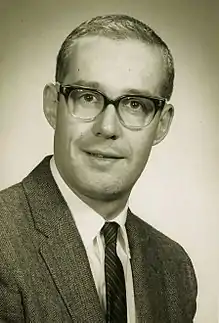Frank Hole | |
|---|---|
 | |
| Academic background | |
| Education |
|
| Doctoral advisor | Robert Braidwood |
| Academic work | |
| Discipline | Anthropology |
| Sub-discipline | |
| Institutions |
|
Frank Hole (born 1931) is an American Near Eastern archaeologist known for his work on the prehistory of Iran, the origins of food production, and the archaeology of pastoral nomadism. He is C. J. MacCurdy Professor Emeritus of Anthropology at Yale University.[1]
Education and career
Hole studied at Cornell College (BA, 1953), Harvard University (1957–58), and the University of Chicago (MA, 1958; PhD, 1961). He worked at Rice University from 1961 to 1980, and was a full professor from 1968. In 1980, he moved to Yale University, where he served as the C. J. MacCurdy Professor of Anthropology (1996–2005) and the head of the division of anthropology at the Peabody Museum (1996–2005). He retired in 2005 and was appointed a senior research scientist and professor emeritus. He has held visiting professorships at the University of Colorado (1971), Yale (1972–1973), and Masaryk University.[2]
Hole was elected a Fellow of the American Association for the Advancement of Science in 1966,[2] a member of the National Academy of Sciences in 1981,[3] and a member of the Connecticut Academy of Science and Engineering in 1983.[2] He received the 2007 lifetime achievement award from the Society for American Archaeology,[4] and a Farabi International Award in 2011.[5]
Research on Iranian prehistory
At Chicago, Hole studied under Robert Braidwood, who was investigating the origins of food production in Southwest Asia.[6] In 1959, when political instability prevented him from returning to his excavations at Jarmo in Iraqi Kurdistan, Braidwood began working across the border in the Iranian part of the Zagros Mountains.[7][8] Hole joined Braidwood's team,[9] which in 1959 conducted the first systematic surveys of early prehistory in Iran, in the region of Kermanshah,[10][11] and the following year conducted excavations at Asiab, Sarab, and Warwasi.[7] After this Braidwood moved on to southeastern Turkey,[8] but Hole and another of his students, Kent Flannery, returned to work in western Iran.[12]
Between 1961 and 1965, Hole and Flannery conducted a number of surveys in Lurestan and Khuzestan, and excavated at Gar Arjeneh, Yafteh, Pasangar, Ghamari, Kunji Cave, Ali Kosh, and (with James Neely) Tepe Sabz.[12][13] These sites produced what was, at the time, some of the earliest evidence for the plant and animal domestication in the world.
He is also known for his pioneering work on the archaeology of pastoral nomads in the Near East, in particular his ethnoarchaeology of Luri pastoralists in western Iran.[14][15]
References
- ↑ "Frank Hole". Department of Anthropology. Yale University. Retrieved 2017-09-05.
- 1 2 3 Hole, Frank (29 September 2011). "CV". Personal website. Retrieved 2017-09-05.
- ↑ "Frank Hole". National Academy of Sciences. Retrieved 2017-09-05.
- ↑ "Lifetime Achievement Award". Society for American Archaeology. Retrieved 2017-09-05.
- ↑ "Foreign Section Winners of FIA". Farabi International Award. Ministry of Science, Research and Technology. Retrieved 2017-09-05.
- ↑ Braidwood, Robert J. Prehistoric Men. 8th ed. Glenview, IL: Scott, Foresman, 1975
- 1 2 Braidwood, Robert J.; Howe, Bruce; Reed, Charles A. (1961). "The Iranian Prehistoric Project". Science. 133 (3469): 2008–2010. Bibcode:1961Sci...133.2008B. doi:10.1126/science.133.3469.2008. JSTOR 1707317. PMID 17754651. S2CID 5869457.
- 1 2 Braidwood, Robert J. (1972). "Prehistoric Investigations in Southwestern Asia". Proceedings of the American Philosophical Society. 116 (4): 310–320. JSTOR 985901.
- ↑ Hole, Frank (4 October 2011). "Field Projects". Personal website. Retrieved 2017-09-05.
- ↑ Roustaei, K.; Nasab, H. Vahdati; Biglari, F.; Heydari, S.; Clark, G. A.; Lindly, J. M. (2004). "Recent Paleolithic Surveys in Luristan". Current Anthropology. 45 (5): 692–707. doi:10.1086/425636. ISSN 0011-3204. S2CID 145585673.
- ↑ Vahdati Nasab, Hamed (2011). "Paleolithic Archaeology in Iran". The International Journal of Humanities. 18 (2). ISSN 2538-2640.
- 1 2 Hole, Frank; Flannery, Kent V. (1968). "The Prehistory of Southwestern Iran: A Preliminary Report". Proceedings of the Prehistoric Society. 33: 147–206. doi:10.1017/S0079497X00014092. ISSN 2050-2729. S2CID 128941631.
- ↑ Hole, Frank; Flannery, Kent (1962). "Excavations at Ali Kosh, Iran, 1961". Iranica Antiqua. 2: 97 – via ProQuest.
- ↑ Matthews, Roger (2003). The Archaeology of Mesopotamia: Theories and Approaches. London: Routledge. p. 187. ISBN 0415253160 – via Google Books.
- ↑ David, Nicholas; Kramer, Carol (2001). Ethnoarchaeology in Action. Cambridge: Cambridge University Press. p. 240. ISBN 0521661056 – via Google Books.